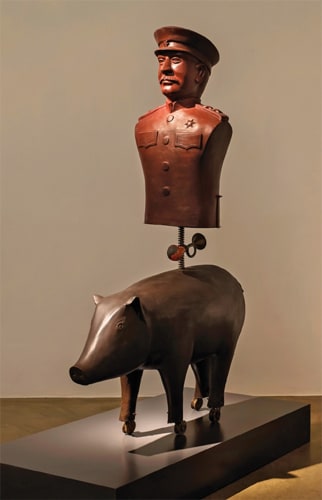Joseph Stalin, a rubber horn, and a pig might seem like an incongruous mix. Yet K. M. Madhusudhanan pulled them all together in his sculpture Parade, 2016. By placing the erstwhile Soviet leader’s torso atop a creature whose name is a byword for greed and ignorance, the artist pulled down a onetime icon from his lofty pedestal. Parade is a three-dimensional rendition of an untitled 2016 charcoal drawing from Madhusudhanan’s ongoing series “The Marx Archive: Logic of Disappearance,” 2014–. In these works, five of which were on display, symbols of power from the Soviet era are depicted in a state of decline. The skeleton of a horse on a tank, dismembered mannequins, a muzzled dog on casters, and forlorn statues of former heroes serve to focus attention on the collapse of the Soviet Union, and with it the failure of the great Marxist dream. Juxtaposed against an inky-black background, these surreal visitations seemed to glow with an inner luminosity. The treatment of these works is informed by the artist’s memories of childhood in the Indian coastal town of Alappuzha. “There is a lighthouse on the shores of my birthplace. These drawings have been created as image fragments made visible by its sweeping light.” There is a decidedly Foucauldian ring to these drawings, with the artist also paying homage to Goya’s black paintings and etchings, Indian filmmaker Ritwik Ghatak’s movie Ajantrik (The Pathetic Fallacy, 1958), and Sergei Eisenstein’s Ivan the Terrible (1944 and 1958).

